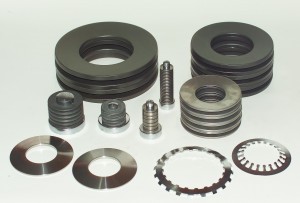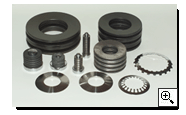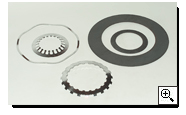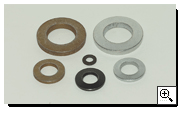BELLEVILLE WASHERS | DISC SPRINGS
Disc springs are conical washers with elastic properties. These springs are resistant to axial loads, proportionally to the displacement produced in the piece. The main characteristic of these elements is the capacity for offering very high forces in reduced spaces, improving what we would obtain with another type of springs.
Types of elastic washers
It is usual to include within the same definition the different types of elastic washers in the market. However, each type has its own characteristics, being prepared to be applied on dynamic works or only with the function to support static loads, maintaining the tension.
The main difference is established by the two main types: those complying with the standard DIN 2093, called disc springs, and those complying with DIN 6796, called pressure washers or belleville washers for static functions such as bolted joints tightening. Likewise, there are other models for specific functions to work together with bearings, valves and other applications. The different types are detailed in the menu.
Stacks
This type of springs allows to carry out combinations of them in a simple way in order to obtain a spring with a displacement force curve which meets our necessities.
This type of units or stack have a practical sense for DIN 2093 springs. As they are conical washers, they can be stacked in parallel (in the same direction) or serial (opposing), resulting in stacks that correctly guided, behaves like a spring. In this sense, parallel stack increases the spring force proportionally according to the number of pieces, whereas serial stack increases the displacement proportionally to the number of units. Combinations of both techniques can be carried out in order to obtain more complex behaviours.
Materials
These products can be made in different materials. Both in DIN 2093 and DIN 6796, the specifications regarding allowable material are provided.
Usually, they are steels with different characteristics according to the type of washer and its use. Stainless steels and other alloys are also used for withstanding corrosion and/or temperature, such as Inconel, which combines resistance to corrosion with resistance to high and low temperatures, offering a non-magnetic material. In the menu, in each type of elastic washer, a description of the possible materials and their characteristics is given.
Calculations
Thanks to Almen and László equations contained in DIN 2092, the force in relation to the displacement in the disc springs or vice versa can be calculated. These equations, which are based on the spring deformation when submitted to a specific force, allow us to calculate the complete force curve vs deflection of that piece. These calculations are also applicable to stacks of serial or parallel disc springs and for different materials.
In CALCULATION PROGRAM , you will find our program for download, which enables these calculations to be made in a simple way. Likewise, based on these equations and through our program, tensions, at different points of the spring, and fatigue can be calculated based on the variation of displacement submitted to.
This information is very useful to determine the suitability of stacks for a specific application. However, it should always be considered as an approximation and not as exact data.
Special measures
In addition to the measures determined by the regulations, such as DIN 2093 and DIN 6796, and those other established as standard and included in this catalogue, springs in other dimensions and materials can be manufactured. In order to do that, please contact our engineers, who will advise you on the dimensions, materials, finishing and coating of the piece to achieve the operation wanted.
COMPRA ONLINE
 Disc springs DIN 2093
Disc springs DIN 2093
Elastic disc springs DIN 2093 are pieces with a great accuracy. They are designed to work in a dynamic way supporting a high number of cycles.
These conical springs provide an elastic axial strength proportional to deformation they suffer. Depending on your needs, it's possible to stack these springs in serial or in parallel to achieve the spring required. To know more about these springs consult: Disc Springs DIN 2093
 Disc springs for bearings
Disc springs for bearings
Disc springs for bearings areassembled with the ball bearings to act as retention devices. Disc springs act as a compensator of thermal expansions during their working.
They also absorb ball bearings maintaining axial load recommended by the manufacturer of the bearing. Depending on its shape, we can show two different springs type: slotted and plain. To know more about it consults this link: Disc springs for bearings



